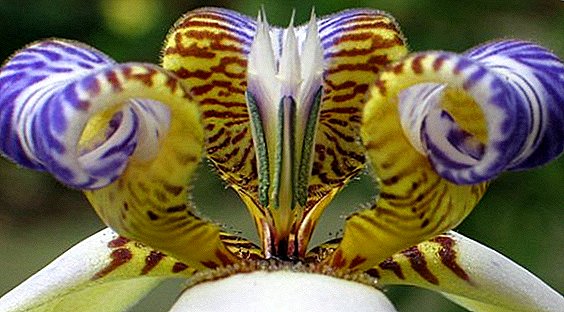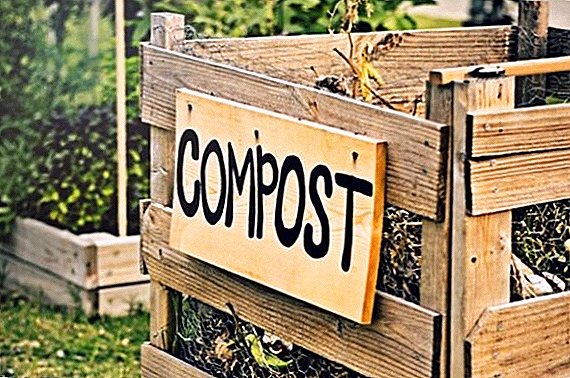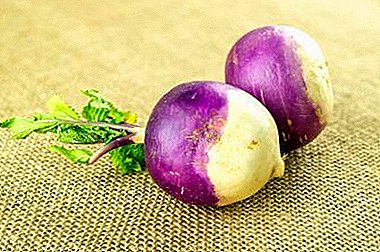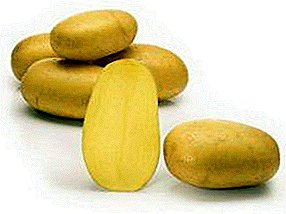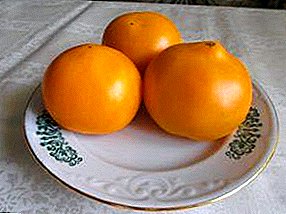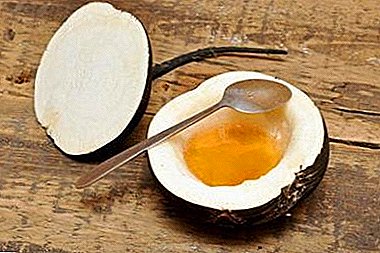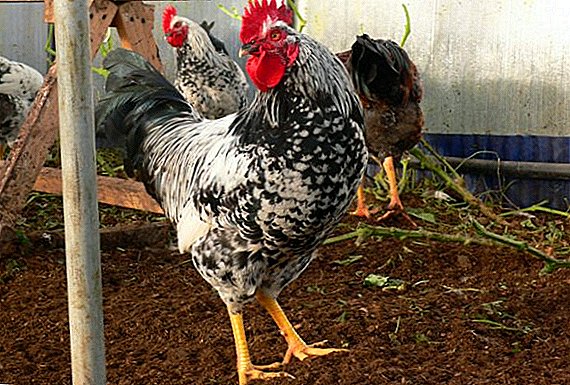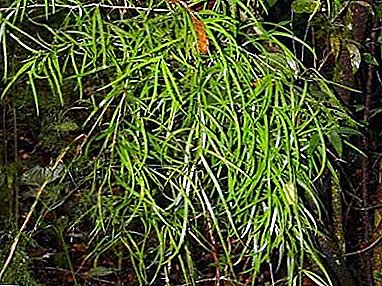
Asparagus Sickle refers to unpretentious plants.
In length reaches more than 7 meters.
Loves frequent watering, fertilizing, nourishing soil.
Propagated by planting seeds and dividing the bush.
Description
 Asparagus Sickle is a beautiful home plant, belongs to the genus Asparagus.
Asparagus Sickle is a beautiful home plant, belongs to the genus Asparagus.
The flower is called the home liana or curly shrub. In nature, it is widespread in the foothills of India, Sri Lanka, the tropics of South Africa and Asia.
The growth of the plant is intense, it grows quickly. In length reaches more than 7 meters. The shoots are graceful with strong ramifications.
Ligneous stems are completely covered with thin hooked spines.
With the help of them, the vine climbs to the sun on the supports and shtambam trees.
The leaves are small, scaly, poorly developed. Cladodyses in the form of sickles, lanceolate, emerald hue. They are located only on the tops of the branches. In width reach 0.5 centimeters, in length from 8 to 10 centimeters.
Flowering occurs in June-August. Flowers tiny, snow-white, collected in a brush on 6-8 centimeters. After flowering, brown egg-shaped berries appear.
Look at some photos with this interesting plant:


Other common types of Asparagus on our website: Sprenger, Metaera.
Home care
Young Asparagus sickle is recommended to buy in nurseries or specialty stores. Small plants can be sold in mini tanks.
You should choose a flower with shiny healthy leaves, not affected by the stems and developed root system. The plant is a perennial.
Price may vary from the size of the representative fauna.
Asparagus in growth is unpretentious. After buying a vine does not require certain systematic action. It is just necessary to wash off the dust and germs with the help of a warm, gentle shower, spray it abundantly and water it. Then choose a flower permanent place on a hill.
Adult specimens immediately pull the line, which they will then twine.
Pruning
 The plant tolerates pruning. Due to the systematic formation increases bushiness.
The plant tolerates pruning. Due to the systematic formation increases bushiness.
You can get a lush bush or elongated vine. In the second case, a flexible stem will need a support with a guide line.
The plant will begin to twist it and vigorously grow in length.
It is recommended to remove loose, diseased and old branches. In their place will grow young new shoots.
Watering
From mid-spring to early autumn, it is recommended to irrigate regularly. It should be abundant and frequent, so that the soil in the tank does not dry out. In winter, watering is reduced to a minimum, as in the cold period the soil remains wet. Icy, not drying out soil, causes rotting of the stems and rhizomes.
IMPORTANT: Water should be separated, soft. It should not contain chlorine and other chemical impurities.
Landing
For planting use nutrient loose earth. The soil should be permeable to a neutral or slightly oxidized environment.
The soil is cooked at home. This will require sea sand, leaf and turf soil in the ratio of 1: 4: 2. Allowed landing in the purchase of universal land for deciduous flora. Since Asparagus Sickle belongs to large branching vines, it is recommended to use wide and deep pots.
The adult rhizome needs development in the upper part of the tubers. The root system of this plant is similar to the rhizome of a tulip or radish roots. This rhizome is recommended to leave a lot of space. Between the soil and the edge of the pot should be left more than 4-5 centimeters. Otherwise, the root system will begin to bulge very hard, leaving no space for additional feeding and watering.
TIP: Before planting in a tank, drainage is created from pebbles or broken bricks.
Transfer
 Young plants are transplanted every year in a large-sized container. The operation must be carried out before the onset of intensive growth. Adults vines transplanted as needed.
Young plants are transplanted every year in a large-sized container. The operation must be carried out before the onset of intensive growth. Adults vines transplanted as needed.
If the roots of the plant began to look out of the drainage, if the flower became cramped or the ground had exhausted the supply of necessary substances, then transplantation is obligatory.
The procedure removes some of the tubers. Complete removal of tubers is prohibited, as they contain a supply of nutrients that provide excellent health for the vine.
During the growing season, the fertilizer procedure is carried out 1 time in 14 days. A good feed for deciduous flowers.
In the winter time, Asparagus Sickle does not need fertilizers.
Growing up
Due to the long stems, reaching a length of more than 7 meters, the plant is planted in pots. From the trunk draw a line, on which the vine is actively twisted and grows. The plant loves moderate humidity.
TIP: At too high dryness and elevated temperatures, the crown of vines should be frequently sprayed.
Sometimes the flower arrange a gentle warm shower. This procedure refreshes Asparagus, washes away dust, which promotes the reproduction of pests.
Breeding
 The plant propagates by planting seeds and dividing the bush.
The plant propagates by planting seeds and dividing the bush.
The rhizome must be divided into several equal parts so that each of them contains mature shoots and actively developed roots.
When planting seeds, most of the material is defective. Seeds of this species of Asparagus are tight.
Sowing is done in mid-February in breathable soil.
Seeds are sprinkled with soil and sprayed with water from a sprayer.
Then create a homemade greenhouse from a glass jar or cut plastic bottle.
The temperature should be stable at 25 ° C.
Detailed instructions for growing asparagus from seeds can be seen in the video:
Temperature
During the growing season from spring to autumn, Asparagus loves temperatures ranging from 20 to 25 ° C. In the summer, the plant is taken out in a greenhouse, garden or balcony. It is necessary to choose shaded corners, protected from drafts and wind.
The room in which the flower is located is often ventilated, providing it with an influx of fresh summer air. In winter, the plant needs rest. At this time, the shoots slow down in its development.
IMPORTANT: In winter, the temperature should not fall below 10 ° C.
Lighting
In nature, the plant is accustomed to shady foothills and tropics. Therefore, the plant does not like direct sunlight. Indoors, the flower is placed on the east and west sides.
To the north, Asparagus will lack sunlight. This is fraught with strong stretching of shoots and loss of saturated color.
On the south side, the plant will wither because of the constant sunlight that will burn soft clauses.
Benefit and harm
 Asparaguses are able to grow into green tall walls consisting of graceful stems.
Asparaguses are able to grow into green tall walls consisting of graceful stems.
Twigs are tied to the bamboo supports in the form of an arc or create carpet green columns.
Thanks to this decor, the apartment will seem like a beautiful greenhouse.
Stems plants decorate wedding bouquets.
Branches, flowers, brown berries and leaves can not be consumed in animals and humans.
They cause poisoning and allergic reactions.
Do not allow the juice of the leaves to fall on the skin or eyes.
In this case, severe burns may occur.
Diseases and pests
The plant is subject to attacks of spider mites.
Especially if the room has dry air and high temperature characteristics.
To get rid of the pest, the stems are washed in a stream of warm water of 45 ° C. The boles are then sprayed with the Actellic chemical.
Asparagus is often affected by root rot.
The disease occurs when the soil is over-wetted and the flower is in the gulf. Due to dry air, elevated temperature factors and an overabundance of sunlight, tips of cladodes can dry out. To eliminate the disease the flower must be changed location.
Asparagus sickle can be affected by a spider mite.
Does not like direct sunlight. Grows well at stable temperatures. Young plants are transplanted every year in a large-sized container.



